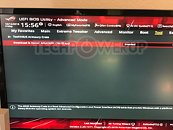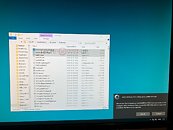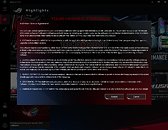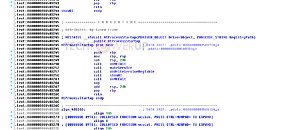Tuesday, October 23rd 2018

ASUS Z390 Motherboards Automatically Push Software into Your Windows Installation
During testing for our Intel Core i9-9900K review we found out that new ASUS Z390 motherboards automatically install software and drivers to your Windows 10 System, without the need for network access, and without any user knowledge or confirmation. This process happens in complete network-isolation (i.e. the machine has no Internet or LAN access). Our Windows 10 image is based on Windows 10 April 2018 Update and lacks in-built drivers for the integrated network controllers.
Upon first boot, with the machine having no LAN or Internet connectivity, we were greeted by an ASUS-specific window in the bottom right corner of our screen, asking whether we'd like to install the network drivers and download "Armoury Crate". This got us curious and we scanned the system for any files that aren't part of the standard MS Windows installation. We discovered three ASUS-signed files in our Windows 10 System32 folder, which, so it seems, magically appeared on our harddrive out of thin air. Upon further investigation we also found a new, already running, system service called "AsusUpdateCheck."These files could not have come from either our Windows image or the network, leaving the motherboard's 16-megabyte UEFI BIOS as the only suspect. The files themselves, which total around 3.6 MB in size, appear harmless, and belong to an ASUS-made program called "ASUS Armoury Crate." This program fetches the latest drivers for your hardware from ASUS servers, and installs them for you in an automated process with little user-intervention. This is a very useful feature, as it establishes a method to install network driver and other drivers easily, without the need for a physical driver disc (in times where nobody has an optical drive anymore). After digging around in the UEFI BIOS, we managed to find a fairly nondescript option "Download and Install ARMOURY CRATE app", which of course defaults to "on"; and it's not easy to find, being located in the "Tool" section of the BIOS setup.
The ASUS UEFI firmware exposes an ACPI table to Windows 10, called "WPBT" or "Windows Platform Binary Table". WPBT is used in the pre-built OEM industry, and is referred to as "the Vendor's Rootkit." Put simply, it is a script that makes Windows copy data from the BIOS to the System32 folder on the machine and execute it during Windows startup - every single time the system is booted. According to the Microsoft WPBT reference, which describes this feature as useful for "anti-theft software", this binary is a "native, user-mode application that is executed by the Windows Session Manager during operating system initialization.", which means "before all other programs, with administrative privileges". This gives pretty much full control over everything, including protected folders and the registry.The ASUS executable unpacks two more files, registers the "AsusUpdateCheck" service and launches it. Once the desktop is loaded, it manifests itself as a bloatware-looking notification near our system tray, requesting you to install the ASUS Armoury Crate software, by fetching the rest of its installer payload from the Internet. Interestingly, it also installs a basic driver to get the integrated network controller working, which is a nice feature. Windows 10 doesn't support the new Z390 integrated Ethernet controller out of the box. This method of writing data to protected areas of the boot drive may not be uncommon with OEM pre-built desktops and notebooks, but for the PC DIY space, in which consumers seek a higher degree of control and privacy over their hardware and software, it is a first and comes across as intrusive. It should normally take a lot of privilege for anything to write to your System32 folder without user-intervention, at least a UAC dialog authenticating the user's consent. Lenovo has used the same method in 2015, which resulted in a huge scandal. They automatically installed a rootkit, which logged data and pushed bloatware into the user's system.
Our motherboard was supplied within the European Union, and yet the software lacks a GPDR-compliant user consent dialog. If nothing else, a person's IP address will be transmitted to ASUS without consent, possibly more, including details like motherboard model, system specs and installed hardware.
We poked and prodded with the service a bit. Deleting the files (and/or the service) simply restores them at the next reboot. Clicking "cancel" in the first instance of the pop-up doesn't end the service, which keeps running in the background until you manually disable it (and it comes back at next reboot). The only way you can ensure the files stay deleted is by disabling the "ASUS Armoury Crate" option in the UEFI setup program, which disables the ACPI-WPBT table. Running the download & install, and then disagreeing with the license agreement will keep Armoury Crate installed on your system. Even when the Armoury Crate Uninstaller is run from "Programs & Software", the AsusUpdateCheck service doesn't get uninstalled, and the uninstaller also forgets to remove a second service it installed.
By default, the ASUS UEFI setup program for our motherboard has the "Download and Install Armoury Crate App" option enabled. Unsuspecting users who glossed over their UEFI setup configuration before installing their OS for the first time, will see the Armoury Crate pop-up even if their machines are not configured to access the Internet. This would do wonders for increasing the user-base of ASUS' software, but are you comfortable with something like this? Given NAND flash pricing, what stops motherboard vendors from embedding a flash-based USB mass-storage device directly onto their motherboards that installs a host of driver software and sponsored bloatware automatically?
If you put aside the privacy concerns for a moment, there are both advantages and disadvantages for what ASUS is trying to accomplish. Since it's enabled by default, this method makes installing drivers and system software easier than ever, since it also gets the network controller to work. It's particularly useful given that motherboard vendors continue to ship drivers on a DVD, and optical disc drives are on the decline, leaving people with little option but to copy their drivers onto a USB flash drive, just to get the NIC working. The application also fetches the very latest (most stable) versions of drivers found on ASUS website. The most obvious disadvantage is cybersecurity. If any of ASUS' on-chip code has security vulnerabilities that can be exploited, there is little way to fix it but with BIOS updates from ASUS.
ASUS needs to make a few changes and release UEFI BIOS updates, on the double. One option could be to disable the Armour Create option in BIOS by default, so unsuspecting users don't get these files. It could be advertised in the home-screen of the UEFI setup instead. Another option could be to properly clean up the installed files if the users chooses to not use Armoury Crate and not install them again on next reboot. Also required is a GPDR-compliant license agreement, that clarifies which data is collected, how it is processed, and whether it is shared with third parties. While this probably won't happen, some kind of ASUS warranty to include liability for any future malware that exploits WPBT to survive OS reinstalls, would go a long way.
We're sure that as a market-leading motherboard vendor, the intentions behind this couldn't have been bad. It only needs a bit of polish, and a lot of transparency with the user.
Upon first boot, with the machine having no LAN or Internet connectivity, we were greeted by an ASUS-specific window in the bottom right corner of our screen, asking whether we'd like to install the network drivers and download "Armoury Crate". This got us curious and we scanned the system for any files that aren't part of the standard MS Windows installation. We discovered three ASUS-signed files in our Windows 10 System32 folder, which, so it seems, magically appeared on our harddrive out of thin air. Upon further investigation we also found a new, already running, system service called "AsusUpdateCheck."These files could not have come from either our Windows image or the network, leaving the motherboard's 16-megabyte UEFI BIOS as the only suspect. The files themselves, which total around 3.6 MB in size, appear harmless, and belong to an ASUS-made program called "ASUS Armoury Crate." This program fetches the latest drivers for your hardware from ASUS servers, and installs them for you in an automated process with little user-intervention. This is a very useful feature, as it establishes a method to install network driver and other drivers easily, without the need for a physical driver disc (in times where nobody has an optical drive anymore). After digging around in the UEFI BIOS, we managed to find a fairly nondescript option "Download and Install ARMOURY CRATE app", which of course defaults to "on"; and it's not easy to find, being located in the "Tool" section of the BIOS setup.
The ASUS UEFI firmware exposes an ACPI table to Windows 10, called "WPBT" or "Windows Platform Binary Table". WPBT is used in the pre-built OEM industry, and is referred to as "the Vendor's Rootkit." Put simply, it is a script that makes Windows copy data from the BIOS to the System32 folder on the machine and execute it during Windows startup - every single time the system is booted. According to the Microsoft WPBT reference, which describes this feature as useful for "anti-theft software", this binary is a "native, user-mode application that is executed by the Windows Session Manager during operating system initialization.", which means "before all other programs, with administrative privileges". This gives pretty much full control over everything, including protected folders and the registry.The ASUS executable unpacks two more files, registers the "AsusUpdateCheck" service and launches it. Once the desktop is loaded, it manifests itself as a bloatware-looking notification near our system tray, requesting you to install the ASUS Armoury Crate software, by fetching the rest of its installer payload from the Internet. Interestingly, it also installs a basic driver to get the integrated network controller working, which is a nice feature. Windows 10 doesn't support the new Z390 integrated Ethernet controller out of the box. This method of writing data to protected areas of the boot drive may not be uncommon with OEM pre-built desktops and notebooks, but for the PC DIY space, in which consumers seek a higher degree of control and privacy over their hardware and software, it is a first and comes across as intrusive. It should normally take a lot of privilege for anything to write to your System32 folder without user-intervention, at least a UAC dialog authenticating the user's consent. Lenovo has used the same method in 2015, which resulted in a huge scandal. They automatically installed a rootkit, which logged data and pushed bloatware into the user's system.
Our motherboard was supplied within the European Union, and yet the software lacks a GPDR-compliant user consent dialog. If nothing else, a person's IP address will be transmitted to ASUS without consent, possibly more, including details like motherboard model, system specs and installed hardware.
We poked and prodded with the service a bit. Deleting the files (and/or the service) simply restores them at the next reboot. Clicking "cancel" in the first instance of the pop-up doesn't end the service, which keeps running in the background until you manually disable it (and it comes back at next reboot). The only way you can ensure the files stay deleted is by disabling the "ASUS Armoury Crate" option in the UEFI setup program, which disables the ACPI-WPBT table. Running the download & install, and then disagreeing with the license agreement will keep Armoury Crate installed on your system. Even when the Armoury Crate Uninstaller is run from "Programs & Software", the AsusUpdateCheck service doesn't get uninstalled, and the uninstaller also forgets to remove a second service it installed.
By default, the ASUS UEFI setup program for our motherboard has the "Download and Install Armoury Crate App" option enabled. Unsuspecting users who glossed over their UEFI setup configuration before installing their OS for the first time, will see the Armoury Crate pop-up even if their machines are not configured to access the Internet. This would do wonders for increasing the user-base of ASUS' software, but are you comfortable with something like this? Given NAND flash pricing, what stops motherboard vendors from embedding a flash-based USB mass-storage device directly onto their motherboards that installs a host of driver software and sponsored bloatware automatically?
If you put aside the privacy concerns for a moment, there are both advantages and disadvantages for what ASUS is trying to accomplish. Since it's enabled by default, this method makes installing drivers and system software easier than ever, since it also gets the network controller to work. It's particularly useful given that motherboard vendors continue to ship drivers on a DVD, and optical disc drives are on the decline, leaving people with little option but to copy their drivers onto a USB flash drive, just to get the NIC working. The application also fetches the very latest (most stable) versions of drivers found on ASUS website. The most obvious disadvantage is cybersecurity. If any of ASUS' on-chip code has security vulnerabilities that can be exploited, there is little way to fix it but with BIOS updates from ASUS.
ASUS needs to make a few changes and release UEFI BIOS updates, on the double. One option could be to disable the Armour Create option in BIOS by default, so unsuspecting users don't get these files. It could be advertised in the home-screen of the UEFI setup instead. Another option could be to properly clean up the installed files if the users chooses to not use Armoury Crate and not install them again on next reboot. Also required is a GPDR-compliant license agreement, that clarifies which data is collected, how it is processed, and whether it is shared with third parties. While this probably won't happen, some kind of ASUS warranty to include liability for any future malware that exploits WPBT to survive OS reinstalls, would go a long way.
We're sure that as a market-leading motherboard vendor, the intentions behind this couldn't have been bad. It only needs a bit of polish, and a lot of transparency with the user.




75 Comments on ASUS Z390 Motherboards Automatically Push Software into Your Windows Installation
Asking Asus to "properly clean up" is maybe asking too much, given it's decades old history of doing the contrary? Needing underground tools like "AI Suite cleaner" to do it? It's amazing that they do not hire software engineers with enough qualification... As you say "they will perfect it"... slowly... I'll leave it here. ;)
Nothing scares me more than big cheap flashroms on motherboards... spyware, vendors, all of them have the power to misuse this.Comprehension fail.
Besides, don't give us the "for your convenience" justification, being a builder is inconvenient per nature, and that's how we like it.
---> Lawyers want to know your location/
---> EU administration intensifies.
Me:
This shouldn't be possible as far as I am concerned, but since that ship has sailed,AT LEAST have some sense and turn it off by default, ASUS.Amazon is claiming a backlog to december last I heard...
2. no
3. HELLL NO
No asus craploaders fo me....
isn't it bad enuff that we have to deal with hackers, spywarz, malwarez, meltdowners, specters etc etc etc, and now this........wTf ???????????
lol
Great... jut what I need: Another uncertified software tool downloading software and installing it without my knowledge. Another hackers paradise has been created. Nice move ASUS.
Yet another reason to having nothing to do with Microsift or ASUS.
They are drivers that are built in somewhere on the motherboard. They are loaded, not downloaded from the internet..
Will probably be my last ASUS board until they stop doing this BS. I dont need my motherboard pushing files to my PC for any reason.
I didn't mind being assisted to find driver's and I doubt first time builders or OEM builders mind.
I believe it to have been a good faith , easy use feature that IS easily disabled.
It just should be advertised and easily enabled and default to off.
"If you put aside the privacy concerns for a moment"
in this day and age? put privacy concerns aside! lol like we have a choice, our privacy is taken at any given chance these days, no matter what ya do....
Also, what software? I don't need any software for a motherboard. In fact, I don't want any.
1. disabled
2. install network driver only (simply copy and execute .inf install once) (default)
3. ammo crate?
and they should ask on startup maybe?